General Mills Bundle
How did a single flour mill evolve into a global food empire?
Discover the captivating General Mills SWOT Analysis, a journey that began in 1866 with a flour mill in Minneapolis, Minnesota. From its humble origins, this company has transformed into a global food giant, shaping the way we eat. Explore the fascinating General Mills history and its remarkable evolution over the decades.
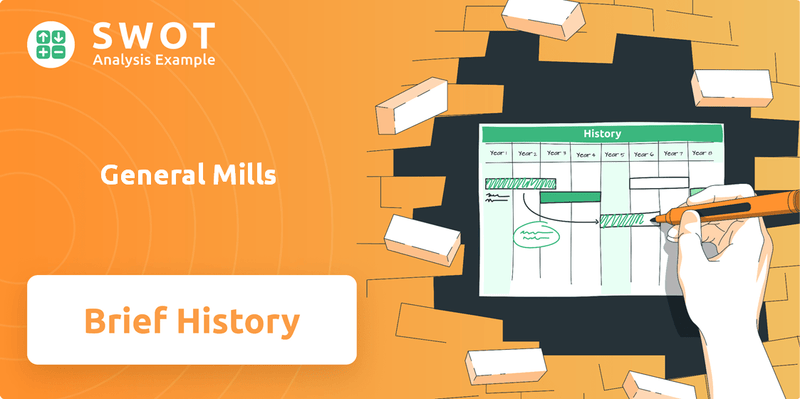
The General Mills company story is a compelling narrative of innovation and strategic adaptation within the competitive landscape of food companies. Its early focus on flour milling quickly expanded to encompass a diverse portfolio of cereal brands and other consumer favorites. Understanding the General Mills early years and its strategic moves provides valuable insights into its enduring success and its continued relevance in today's market, especially as one of the most prominent Minnesota companies.
What is the General Mills Founding Story?
The story of the General Mills company begins on June 20, 1928. This pivotal date marks the official formation of General Mills, a significant event in the history of food companies.
James Ford Bell, then president of the Washburn-Crosby Company, spearheaded the merger. This consolidation brought together 26 flour mills, transforming the milling industry into a national enterprise. The roots of the company stretch back to the Minneapolis Milling Company, established in 1856.
Cadwallader C. Washburn later acquired the Minneapolis Milling Company. In 1866, he constructed the Washburn 'B' Mill in Minneapolis, Minnesota, a substantial undertaking for its time. The company later partnered with John Crosby in 1877 to form the Washburn-Crosby Company.
Early pioneers recognized the growing demand for high-quality flour. The Great Mill Disaster of May 2, 1878, destroyed the Washburn 'A' Mill. Cadwallader Washburn rebuilt the mill and introduced safer milling technologies.
- The company's commitment to quality was evident when its flour brands won awards at the Millers' International Exhibition in 1880.
- This led to the rebranding of their top prize winner as 'Gold Medal' flour.
- The original business model focused on flour milling and distribution.
- Initial funding came from private investments and the founders' capital.
The late 19th and early 20th centuries saw industrial expansion and urbanization. This created a demand for standardized, high-quality food products, which set the stage for the formation of General Mills. The company's early success was built on its ability to meet this demand.
In recent years, General Mills has continued to innovate and adapt. In 2024, the company reported net sales of approximately $20.1 billion. The company's focus on product innovation and strategic acquisitions has helped it maintain its position in the competitive food industry. General Mills continues to be a major player in the cereal industry and beyond.
General Mills SWOT Analysis
- Complete SWOT Breakdown
- Fully Customizable
- Editable in Excel & Word
- Professional Formatting
- Investor-Ready Format
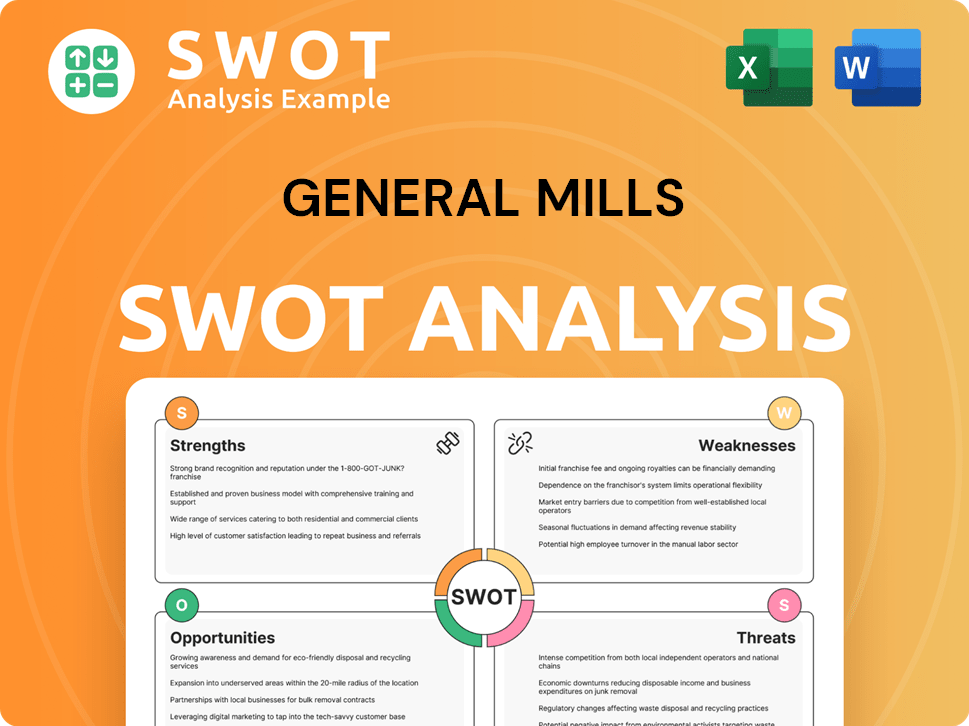
What Drove the Early Growth of General Mills?
Following its formation in 1928, General Mills experienced significant early growth and expansion. This period involved strategic diversification beyond its initial flour milling business. The company's shares began trading on the New York Stock Exchange on November 30, 1928, which helped to raise capital for further expansion. This early phase set the stage for the company's evolution into a major player in the food industry and beyond.
In 1928, the year General Mills was founded, the company acquired the Wichita Mill and Elevator Company, strengthening its milling presence. The initial public offering (IPO) of General Mills shares on the New York Stock Exchange took place on November 30, 1928, at $65 per share. By 1928, General Mills had 5,800 employees and annual sales of $123 million, marking a strong start for the new entity.
The 1930s were crucial for General Mills, with the introduction of several products that became household staples. Bisquick, the first baking mix, was launched in 1931. Kix, the company's first puffed ready-to-eat cereal, debuted in 1937, followed by Cheerios in 1941 (originally Cheerioats), which would become the number one cereal in the United States.
General Mills pioneered innovative marketing strategies, particularly through radio. Its predecessor, Washburn Crosby Company, acquired Minneapolis radio station WLAG in 1924, renaming it WCCO. This allowed for new marketing ideas, including the first singing commercial and Betty Crocker's first cooking show. These early marketing efforts helped build brand recognition and consumer loyalty.
The company expanded beyond food in the 1960s, acquiring toy companies like Rainbow Crafts (Play-Doh) in 1965, Kenner Toy Company in 1967, and Parker Brothers in 1968. This diversification led to General Mills becoming the world's largest toymaker. Further expansion included entering the restaurant industry with the acquisition of Red Lobster in 1970 and the launch of The Olive Garden in 1983. To learn more about how General Mills has maintained its market position, check out the Marketing Strategy of General Mills.
General Mills PESTLE Analysis
- Covers All 6 PESTLE Categories
- No Research Needed – Save Hours of Work
- Built by Experts, Trusted by Consultants
- Instant Download, Ready to Use
- 100% Editable, Fully Customizable
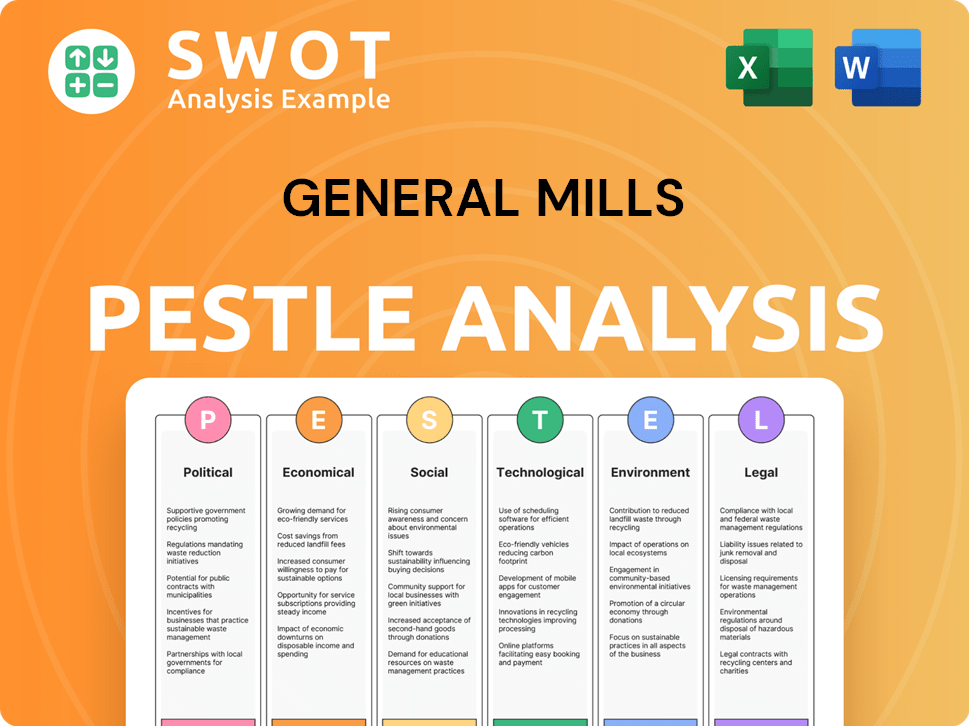
What are the key Milestones in General Mills history?
The General Mills company's history is marked by significant milestones, from groundbreaking product launches to strategic acquisitions that have shaped its trajectory in the food industry. These achievements reflect the company's adaptability and commitment to innovation, solidifying its position as a leading player in the global market.
| Year | Milestone |
|---|---|
| 1921 | Creation of Betty Crocker as a marketing persona, a significant innovation in consumer engagement. |
| 1924 | Introduction of Wheaties, a cereal that became a staple in American households. |
| 1931 | Launch of Bisquick, a versatile baking mix that simplified home cooking. |
| 1941 | Introduction of Cheerios (originally Cheerioats), which later became the number one cereal in the U.S. |
| 1953 | Development of the Ryan flight recorder, a precursor to the modern airplane black box. |
| 1956 | Introduction of the tear-strip for easy-to-open packages. |
| 2001 | Acquisition of The Pillsbury Company, one of the most significant events in its history. |
| 2018 | Acquisition of Blue Buffalo, expanding into the pet food market. |
Innovations at General Mills have consistently set industry standards, from pioneering new technologies to developing effective marketing strategies. The company's focus on product development and consumer engagement has been a key factor in its sustained success and market leadership.
In the 1930s, General Mills pioneered the puffing gun, a technology that created puffed cereals like Kix and Cheerios. This innovation revolutionized cereal production, enhancing both texture and appeal.
The Anderson sealer, introduced in 1939, improved flour packaging. This innovation helped preserve product quality and extended shelf life, benefiting both consumers and the company.
The creation of Betty Crocker in 1921 was a major marketing innovation. This persona became a symbol of home baking and a trusted source for recipes and advice, building strong brand loyalty.
In 1956, General Mills introduced the tear-strip for easy-to-open packages. This simple yet effective innovation improved consumer convenience and enhanced the overall product experience.
In 1953, General Mills developed the Ryan flight recorder. This engineering feat, done in partnership with the University of Minnesota, was a precursor to the modern airplane black box.
The introduction of iconic products such as Bisquick, Wheaties, and Cheerios. These products have become household names and have significantly contributed to the company's revenue.
Despite its successes, General Mills has faced challenges, including economic downturns, competitive pressures, and shifts in consumer behavior. The company's ability to adapt and innovate has been crucial in overcoming these obstacles and maintaining its market position.
General Mills has navigated various market downturns throughout its history. Economic fluctuations and changing consumer behaviors have required the company to adapt its strategies.
The company faces constant competition from other major food companies and emerging brands. Staying ahead requires continuous innovation and strategic marketing efforts.
During World War II, General Mills restructured its factories to produce equipment for the navy and other war efforts. This demonstrated the company's adaptability and commitment to national service.
In recent years, General Mills has faced inflationary pressures and shifting supply chains. The company has maintained a resilient financial posture through rigorous portfolio management.
Reduced consumer confidence and inventory headwinds in 2025 present challenges. General Mills is committed to enhancing its competitive position through cost savings and strategic initiatives.
The 2018 acquisition of Blue Buffalo in the pet food space has been a major success, with the brand surpassing $2 billion in annual revenue by 2025. This has helped the company diversify its portfolio.
General Mills Business Model Canvas
- Complete 9-Block Business Model Canvas
- Effortlessly Communicate Your Business Strategy
- Investor-Ready BMC Format
- 100% Editable and Customizable
- Clear and Structured Layout
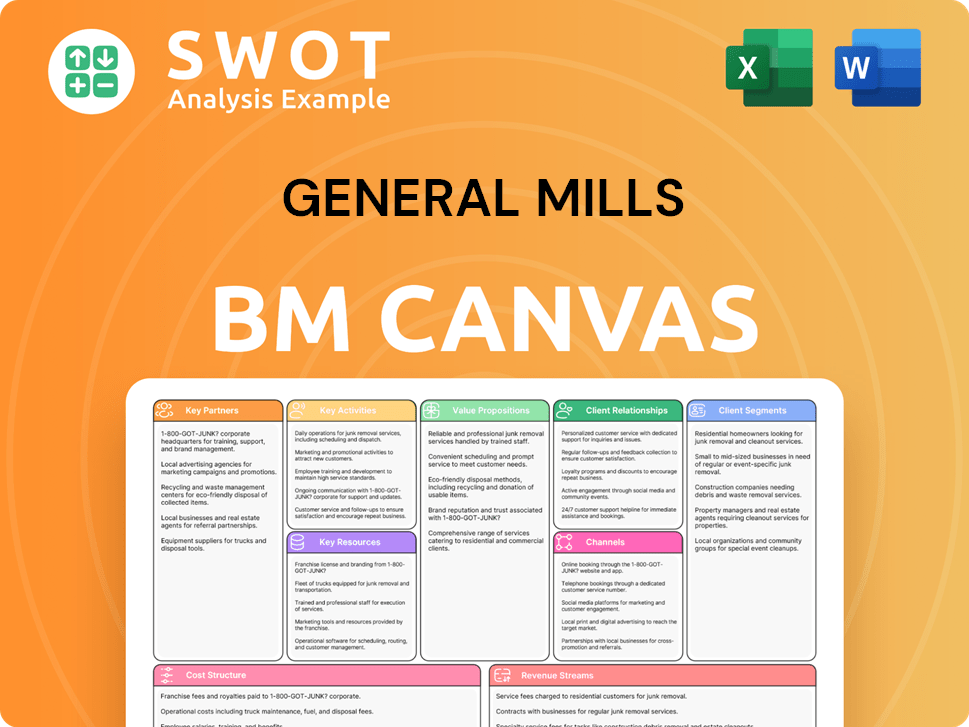
What is the Timeline of Key Events for General Mills?
The General Mills company has a rich General Mills history. It began with the Minneapolis Milling Company in 1856. Over the years, it has grown through mergers and acquisitions, launching iconic brands and adapting to changing consumer preferences. The company's journey showcases its evolution from a flour mill to a global food giant.
| Year | Key Event |
|---|---|
| 1856 | Robert Smith incorporated the Minneapolis Milling Company. |
| 1866 | Cadwallader Washburn built his first flour mill in Minneapolis, which became the foundation of the company. |
| 1877 | Washburn partnered with John Crosby to form the Washburn-Crosby Company. |
| 1878 | The Washburn 'A' Mill was destroyed by an explosion but was rebuilt with enhanced safety standards. |
| 1880 | Washburn-Crosby flour won a gold medal, leading to the 'Gold Medal' flour brand. |
| 1921 | The fictional marketing persona Betty Crocker was created. |
| 1924 | Wheaties, a ready-to-eat cereal, was introduced. |
| June 20, 1928 | General Mills was formed by merging Washburn-Crosby with 26 other mills. |
| 1931 | Bisquick, the first baking mix, was introduced. |
| 1941 | Cheerioats (later Cheerios) was launched. |
| 1953 | The Ryan flight recorder (precursor to the black box) was developed. |
| 1965 | The company acquired Rainbow Crafts, the maker of Play-Doh. |
| 1970 | The company acquired the Red Lobster restaurant chain. |
| 1977 | The company acquired U.S. rights to the Yoplait yogurt brand. |
| 2001 | The company acquired The Pillsbury Company. |
| 2018 | The company acquired Blue Buffalo Pet Products, Inc. for $8 billion. |
| 2025 | The Blue Buffalo brand is projected to surpass $2 billion in annual revenue. |
| June 25, 2025 | The company plans to report fiscal 2025 fourth quarter and full year financial results. |
The company is focused on its 'Accelerate' strategy, which includes Boldly Building Brands, Relentlessly Innovating, Unleashing Scale, and Standing for Good.
The company aims for long-term sustainable growth and top-tier shareholder returns.
It involves investing in iconic brands and increasing media investment in fiscal 2025.
The company plans to increase new product innovation by 30% and enhance marketing spending in fiscal year 2026.
The focus is on 'fewer but more impactful innovations' targeting health-conscious and convenience-driven consumers.
This includes plant-based alternatives and premiumized cereals.
The company is investing in digital transformation, using data analytics and e-commerce.
This is to anticipate consumer trends and optimize supply chain operations.
It is also working on saving an additional $100 million beyond annual productivity savings.
The company anticipates continued improvements in pound volume and household penetration in fiscal 2026.
The long-term target is 2% to 3% top-line growth.
Leadership emphasizes the company's strong position to deliver sustainable growth.
General Mills Porter's Five Forces Analysis
- Covers All 5 Competitive Forces in Detail
- Structured for Consultants, Students, and Founders
- 100% Editable in Microsoft Word & Excel
- Instant Digital Download – Use Immediately
- Compatible with Mac & PC – Fully Unlocked
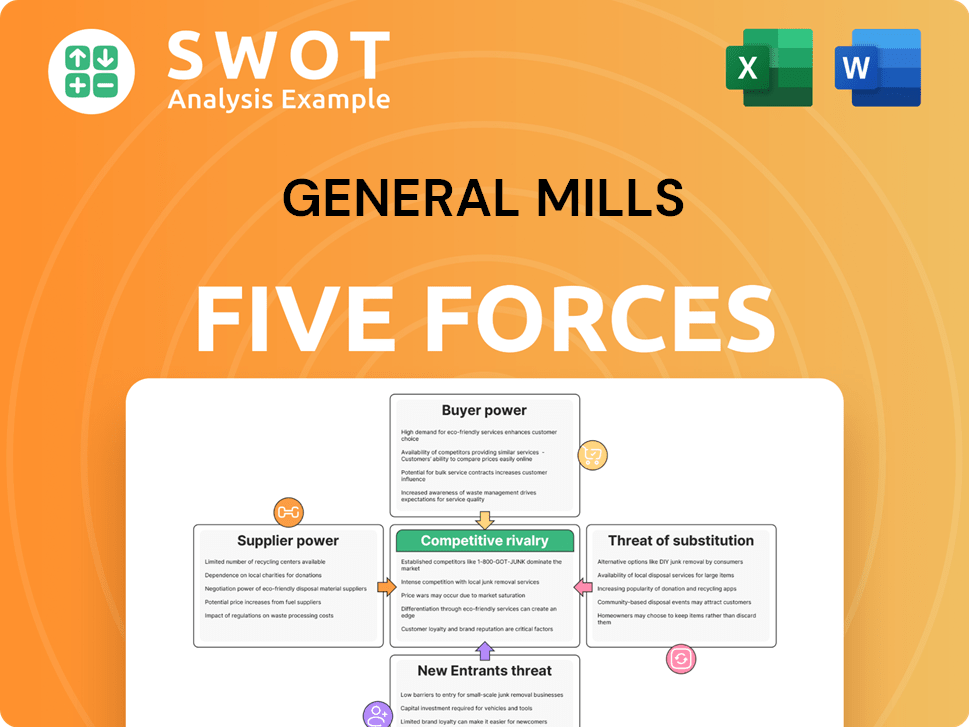
Related Blogs
- What is Competitive Landscape of General Mills Company?
- What is Growth Strategy and Future Prospects of General Mills Company?
- How Does General Mills Company Work?
- What is Sales and Marketing Strategy of General Mills Company?
- What is Brief History of General Mills Company?
- Who Owns General Mills Company?
- What is Customer Demographics and Target Market of General Mills Company?
Disclaimer
All information, articles, and product details provided on this website are for general informational and educational purposes only. We do not claim any ownership over, nor do we intend to infringe upon, any trademarks, copyrights, logos, brand names, or other intellectual property mentioned or depicted on this site. Such intellectual property remains the property of its respective owners, and any references here are made solely for identification or informational purposes, without implying any affiliation, endorsement, or partnership.
We make no representations or warranties, express or implied, regarding the accuracy, completeness, or suitability of any content or products presented. Nothing on this website should be construed as legal, tax, investment, financial, medical, or other professional advice. In addition, no part of this site—including articles or product references—constitutes a solicitation, recommendation, endorsement, advertisement, or offer to buy or sell any securities, franchises, or other financial instruments, particularly in jurisdictions where such activity would be unlawful.
All content is of a general nature and may not address the specific circumstances of any individual or entity. It is not a substitute for professional advice or services. Any actions you take based on the information provided here are strictly at your own risk. You accept full responsibility for any decisions or outcomes arising from your use of this website and agree to release us from any liability in connection with your use of, or reliance upon, the content or products found herein.